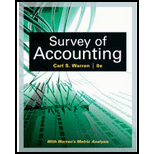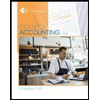
CengageNOWv2, 1 term Printed Access Card for Warren's Survey of Accounting, 8th
8th Edition
ISBN: 9781305961982
Author: Carl Warren
Publisher: Cengage Learning
expand_more
expand_more
format_list_bulleted
Question
Chapter 6, Problem 6.9.1MBA
To determine
Concept Introduction:
This is an efficiency ratio that indicates the conversion of accounts receivable into cash. This ratio is calculated by dividing the Net credit Sales by the Average accounts receivable. The formula to calculate this ratio is as follows:
To Calculate:
The Accounts receivable turnover for years 1 and 2
Expert Solution & Answer
Want to see the full answer?
Check out a sample textbook solution
Students have asked these similar questions
Can you help me solve this financial accounting question using valid financial accounting techniques?
I need the correct answer to this financial accounting problem using the standard accounting approach.
Please provide the solution to this financial accounting question using proper accounting principles.
Chapter 6 Solutions
CengageNOWv2, 1 term Printed Access Card for Warren's Survey of Accounting, 8th
Ch. 6 - At the end of the fiscal year, before the accounts...Ch. 6 - At the end of the fiscal year, Accounts Receivable...Ch. 6 - Prob. 3SEQCh. 6 - The following units of a particular item were...Ch. 6 - Prob. 5SEQCh. 6 - Prob. 1CDQCh. 6 - What types of transactions give rise to accounts...Ch. 6 - In what section of the balance sheet should a note...Ch. 6 - Give two examples of other receivables.Ch. 6 - Carter’s Hardware is a small hardware store in the...
Ch. 6 - Which of the two methods of accounting for...Ch. 6 - Prob. 7CDQCh. 6 - After the accounts are adjusted at the end of the...Ch. 6 - Prob. 9CDQCh. 6 - How are manufacturing inventories different from...Ch. 6 - Prob. 11CDQCh. 6 - Does the term last-in in the LIFO method mean that...Ch. 6 - If inventory is being valued at cost and the price...Ch. 6 - Prob. 14CDQCh. 6 - Prob. 15CDQCh. 6 - Prob. 16CDQCh. 6 - Prob. 17CDQCh. 6 - Prob. 18CDQCh. 6 - Prob. 6.1ECh. 6 - Determine due date and interest on notes Determine...Ch. 6 - Nature of uncollectible accounts MGM Resorts...Ch. 6 - Uncollectible accounts, using direct write-off...Ch. 6 - Uncollectible receivables, using allowance method...Ch. 6 - Writing off accounts receivable Quantum...Ch. 6 - Estimating doubtful accounts Easy Rider...Ch. 6 - Entry for uncollectible accounts Using the data in...Ch. 6 - Providing for doubtful accounts At the end of the...Ch. 6 - Effect of doubtful accounts on net income During...Ch. 6 - Effect of doubtful accounts on net income Using...Ch. 6 - Qualcomm Incorporated (QCOM) is a leading...Ch. 6 - Film costs of DreamWorks DreamWorks Animation SKG...Ch. 6 - Inventory by three methods The units of an item...Ch. 6 - Inventory by three methods; cost of goods sold The...Ch. 6 - Comparing inventory methods Assume that a firm...Ch. 6 - Prob. 6.17ECh. 6 - Lower-of-cost-or-market inventory On the basis of...Ch. 6 - Inventory on the balance sheet Based on thy data...Ch. 6 - Allowance method for doubtful accounts Averys...Ch. 6 - Allowance method for doubtful accounts Averys...Ch. 6 - Allowance method for doubtful accounts Averys...Ch. 6 - Allowance method for doubtful accounts Averys...Ch. 6 - Allowance method for doubtful accounts Averys...Ch. 6 - Allowance method for doubtful accounts Averys...Ch. 6 - Estimate uncollectible accounts For several years....Ch. 6 - Estimate uncollectible accounts For several years....Ch. 6 - Compare two methods of accounting for...Ch. 6 - Compare Two methods of accounting for...Ch. 6 - Inventory by three cost flow methods Details...Ch. 6 - Inventory by three cost flow methods Details...Ch. 6 - Inventory by three cost flow methods Details...Ch. 6 - Inventory by three cost flow methods Details...Ch. 6 - Lower-of-cost-or market inventory Data on the...Ch. 6 - Prob. 6.1MBACh. 6 - Allowance method Using transactions listed in...Ch. 6 - Prob. 6.3MBACh. 6 - Prob. 6.4MBACh. 6 - Lower of cost or market Using data in E6-18,...Ch. 6 - Prob. 6.6.1MBACh. 6 - Prob. 6.6.2MBACh. 6 - Accounts receivable and inventory turnover The...Ch. 6 - Prob. 6.6.4MBACh. 6 - Prob. 6.6.5MBACh. 6 - Prob. 6.6.6MBACh. 6 - Prob. 6.7.1MBACh. 6 - Prob. 6.7.2MBACh. 6 - Prob. 6.7.3MBACh. 6 - Prob. 6.7.4MBACh. 6 - Prob. 6.7.5MBACh. 6 - Prob. 6.7.6MBACh. 6 - Prob. 6.8MBACh. 6 - Prob. 6.9.1MBACh. 6 - Prob. 6.9.2MBACh. 6 - Prob. 6.9.3MBACh. 6 - Prob. 6.9.4MBACh. 6 - Prob. 6.9.5MBACh. 6 - Prob. 6.9.6MBACh. 6 - Prob. 6.10.1MBACh. 6 - Prob. 6.10.2MBACh. 6 - Prob. 6.10.3MBACh. 6 - Prob. 6.10.4MBACh. 6 - Prob. 6.10.5MBACh. 6 - Prob. 6.10.6MBACh. 6 - Prob. 6.1CCh. 6 - Collecting accounts receivable The following is an...Ch. 6 - Ethics and professional conduct in business...Ch. 6 - LIFO and inventory flowInstructions The following...
Knowledge Booster
Learn more about
Need a deep-dive on the concept behind this application? Look no further. Learn more about this topic, accounting and related others by exploring similar questions and additional content below.Similar questions
- Can you explain the correct approach to solve this financial accounting question?arrow_forwardI need help with this financial accounting question using the proper financial approach.arrow_forwardOcean Corp. has a single class of shares. As its year ended December 31, 2025, the company had 5,000,000 shares issued and outstanding. On the stock exchange, these shares were trading at around $7. In the company's accounts, these shares had a value of $50,000,000. The equity accounts also show $650,000 of contributed surplus from previous repurchases of shares. On January 15, 2026, Ocean repurchased and cancelled 250,000 shares at a cost of $7 per share. Later in the year, on August 20, the company repurchased and cancelled a further 475,000 shares at a cost of $14 per share. Required Record the journal entries for the two share transactions in 2026.arrow_forward
- Financial Accountingarrow_forwardIn 2027 Palm Tree Inc. declared $1,000,000 in cash dividends. Its capital structure includes 300,000 common shares; 200,000 cumulative preferred shares "A" each entitled to an annual dividend of $1.00; and 50,000 non-cumulative preferred shares "B" each entitled to an annual dividend of $3.00. The prescribed dividends on both series of preferred shares were last declared and paid in 2025. Required Use the following facts to determine how much each of the three classes of shares receives of the $1,000,000 cash dividend.arrow_forwardI am looking for the correct answer to this financial accounting question with appropriate explanations.arrow_forward
arrow_back_ios
SEE MORE QUESTIONS
arrow_forward_ios
Recommended textbooks for you
 Survey of Accounting (Accounting I)AccountingISBN:9781305961883Author:Carl WarrenPublisher:Cengage Learning
Survey of Accounting (Accounting I)AccountingISBN:9781305961883Author:Carl WarrenPublisher:Cengage Learning Managerial AccountingAccountingISBN:9781337912020Author:Carl Warren, Ph.d. Cma William B. TaylerPublisher:South-Western College Pub
Managerial AccountingAccountingISBN:9781337912020Author:Carl Warren, Ph.d. Cma William B. TaylerPublisher:South-Western College Pub Managerial Accounting: The Cornerstone of Busines...AccountingISBN:9781337115773Author:Maryanne M. Mowen, Don R. Hansen, Dan L. HeitgerPublisher:Cengage Learning
Managerial Accounting: The Cornerstone of Busines...AccountingISBN:9781337115773Author:Maryanne M. Mowen, Don R. Hansen, Dan L. HeitgerPublisher:Cengage Learning College Accounting, Chapters 1-27 (New in Account...AccountingISBN:9781305666160Author:James A. Heintz, Robert W. ParryPublisher:Cengage Learning
College Accounting, Chapters 1-27 (New in Account...AccountingISBN:9781305666160Author:James A. Heintz, Robert W. ParryPublisher:Cengage Learning

Survey of Accounting (Accounting I)
Accounting
ISBN:9781305961883
Author:Carl Warren
Publisher:Cengage Learning

Managerial Accounting
Accounting
ISBN:9781337912020
Author:Carl Warren, Ph.d. Cma William B. Tayler
Publisher:South-Western College Pub

Managerial Accounting: The Cornerstone of Busines...
Accounting
ISBN:9781337115773
Author:Maryanne M. Mowen, Don R. Hansen, Dan L. Heitger
Publisher:Cengage Learning

College Accounting, Chapters 1-27 (New in Account...
Accounting
ISBN:9781305666160
Author:James A. Heintz, Robert W. Parry
Publisher:Cengage Learning
Financial ratio analysis; Author: The Finance Storyteller;https://www.youtube.com/watch?v=MTq7HuvoGck;License: Standard Youtube License